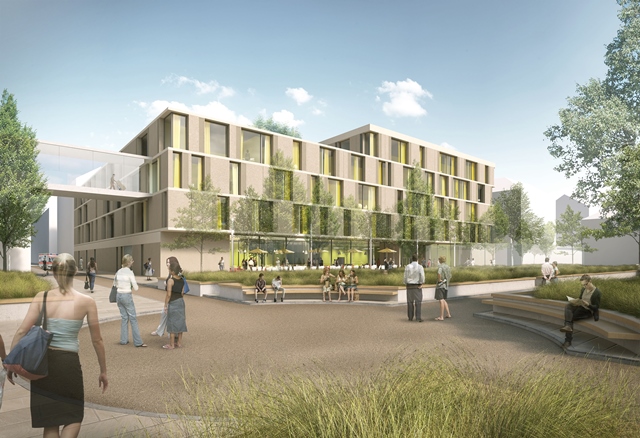
By Sarah Hartwick
The days of hospitals as institutions set apart from surrounding neighbourhoods are in the past. The Ottawa Hospital is committed to building a 21st-century facility that draws the community in to explore its public spaces, both outdoors and indoors.
This might seem a paradigm shift for a hospital but it is an essential one – a great hospital is a cornerstone of a great city.
The Ottawa Hospital is in the early stages of planning a brand new health-care centre in the heart of the nation’s capital. Planned to open in about 10 years, the new centre will replace The Ottawa Hospital’s aging Civic Campus, a building deeply connected to Ottawa’s history. The Civic (formerly the Ottawa Civic Hospital) boasts sections older than the Peace Tower on Parliament Hill and leaves a strong legacy of discovery, research and compassionate care.
Like the Civic before it, the new campus will be Eastern Ontario’s regional trauma centre, and will provide acute, specialized and complex care to the region’s 1.3 million residents.
Designing a 21st-century hospital
The hospital of the future is a community space. It’s laced with and surrounded by nature and greenery. It’s a place where cutting-edge science drives learning and discovery. It’s dedicated to health promotion and wellness alongside health care and healing.
Inside the digitally-connected building, accessible design will be based on scientific evidence, to improve patient flow and access to treatments, and reduce hospital stays, infection spread, stress, staff injuries, and the need for pain medication.
Single-patient rooms with private washrooms reduce the spread of infection, and ceiling lifts reduce staff and patient injuries. Nursing sub-stations allow nurses to take fewer steps and spend more time on patient care. Hallways and elevators separated from public areas move patients more efficiently.
“The hospital of the 21st century will be warm and welcoming,” says Dr. Virginia Roth, The Ottawa Hospital’s incoming Chief of Staff. “It will improve safety, privacy, convenience and comfort. It will reach beyond its walls to provide care where it’s best for the patient and improve the wellness of our community. We will be relying on the voices of our patients and community to achieve this vision.”
Engaging patients and community members is key to designing a patient-centred hospital, says Dr. Roth. “Having patients and community members involved from the beginning will allow us to provide world-class care that’s centred on the needs of patients rather than the convenience of health-care providers.”
Embracing nature
The Ottawa Hospital’s new campus will be built in a naturally beautiful area that is rich in heritage. The site is a unique blend of urban and naturalized landscapes in central Ottawa. It’s nestled next to Dow’s Lake and the Rideau Canal, a UNESCO World Heritage Site where residents and tourists alike gather to skate during Winterlude and stroll through the Tulip Festival displays in the spring.
The new campus will honour the Indigenous land it rests on. It will have areas allocated for greenspace, gardens, walking and bicycling paths, and contemplative areas. The hospital has committed to an open and transparent engagement process with the Ottawa community to determine how these naturalized spaces will look at the new campus, among other important issues.
Research has found that experiencing nature is directly associated with improved mental health, so wellness areas around the hospital are vitally important for patients, visitors, and staff members.
“Getting patients outside for a while can help them feel like they’re not in a hospital any more. It gives them the break they need,” says Linda Ferro-Chartrand, RN in The Ottawa Hospital’s General Campus Intensive Care Unit.
When Stanford University researchers studied participants after they had experienced a walk through nature, they reported lower levels of rumination – repetitive thoughts focused on negative aspects of the self, a known factor for mental illness – and reduced neural activity in the sgPFC, an area of the brain linked to risk for mental illness.
Contact with nature contributes to a healthy workplace, and has a proven major effect on staff. A study at the University of Florida found that staff who took breaks outdoors recorded significantly reduced perceived stress and an overall decrease in health complaints.
“When patients can see something other than the same four walls of their rooms, it’s good for them,” says Ferro-Chartrand. “Getting some sun and fresh air can really boost their mood and change up their thoughts.”
Sarah Hartwick is Communications Officer at The Ottawa Hospital.

